- Yummy top
- Eateries and restaurants
- Uoyu - lunch restaurant
- Kanno
- Tokachiya
- Kitchen Nankai - Jinbocho
- Lamb Meat Tender
- Fujiyoshi - tempura restau.
- Enda - Japanese blue crab
- Fukuda - globefish pot
- Sugimoto
- Fuushi
- Soba restaurant
- Shinano - Akabanebashi
- Juwari-soba Inamuraya
- Ando and Korin
- Toranomon Sunaba
- Izakaya
- subLime and Kakinoki
- Donburi-bachi
- Renka
- Yoshida
- Daini-Chikarashuzo
- Sasagin
- Mugiya - soba izakaya
- Fukube
- Sasashin in Ningyo-cho
- Foreign cuisine
- Pizza Piazza
- Atelier de Fromage
- La Piccola Tavola
- Milieu - salad lunch
- Cafe Moskow - Spanish bar
- Sin Tong Kee
- Sekaihanten
- Miscellaneous
- Cheese & champignon party
- Natural Cheese Contest
- Donburi - rice bowl dish
- Home cooking
- Aji no nanban-zuke
- Spaghetti Carbonara
- Curry rice
Sekaihanten
Kita-Ohtsuka 2-14-8, Toshima-ku, 170-0004 TokyoTel: 03-3576-1757
Sekaihanten
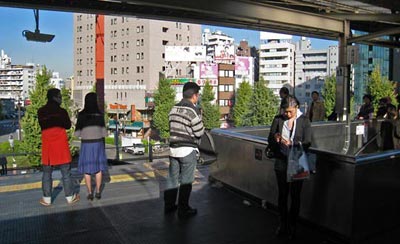
View from the platform of Ohtsuka JR station to the direction where Sekaihanten exists

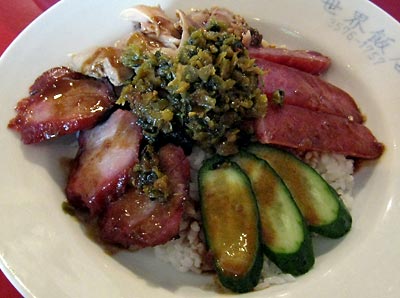
Sanbaofan
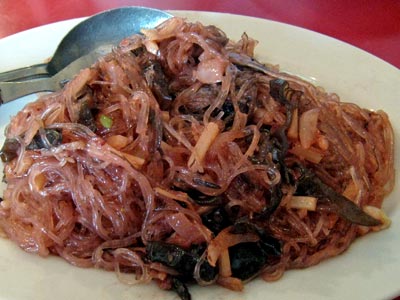
Sautéed rice vermicelli with hair moss
 Yamanote-line is the ring shaped railway line in Tokyo, though this ring is very much distorted. Anyhow, the inside of Yamanote-line - colored light green on the map - can be called as the core of Metropolitan Tokyo. This core area is divided into the northern and southern parts by Chuou-line - red on the map - and these two parts have very different cityscapes and atmospheres.
Yamanote-line is the ring shaped railway line in Tokyo, though this ring is very much distorted. Anyhow, the inside of Yamanote-line - colored light green on the map - can be called as the core of Metropolitan Tokyo. This core area is divided into the northern and southern parts by Chuou-line - red on the map - and these two parts have very different cityscapes and atmospheres. Roughly speaking, the southern part, which includes Roppongi, Aoyama and Omotesando, is modern, rich, young and trendy. On the contrary the northern part looks a bit poor, old and vulgar, but retains much from the past.
Foreign residents in Tokyo appear to separate their territories according to their life style or living standard. Foreigners in Roppongi Hills, for example, are mostly executives of multinational enterprises. Many of them are Caucasians and they frequent exquisite bistros, discos and sushi bars in the area and enjoy their life. Many Japanese people believe that Roppongi, for example, is indeed very international and adore the high-sense life-style of those rich forein residents.
The northern part is also international, but in a different sense. Toshima-ward, whose center is Ikebukuro, is the Asian-ethnic colony. More than half of the foreign inhabitants in Toshima-ward are Chinese, followed by Koreans, Burmese and Filipinos.
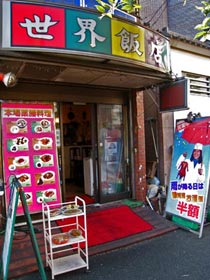 Entrance of Sekaihanten |
Anyhow, this gives us a good chance to experience the true Asia in Tokyo and its culinary world is extremely colorful and thrilling. I would like to recommend Sekaihanten as one of the best ethnic restaurants near Ohtsuka JR station.
Sekaihanten was founded in 1986 by a Canton-Chinese cook born in Vietnam. I started to visit this restaurant in 1996, when we returned home from two years stay in Singapore. I missed in Japan yummy Singapore hawker foods and sought after good Singapore restaurants in Tokyo. Though Sekaihanten is NOT a Singapore restaurant, it offers similar foods such as roast duck Hong Kong style or garlic sautéed kangkung and they are so tasty.
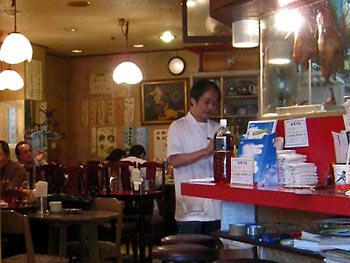
Inside of Sekaihanten
This Sanbaofan - rice with tree treasures - is the representative menu of the house. Three treasures are roast pork, cooked chicken and braised Chinese sausage. I ordered sautéed rice vermicelli with hair moss. Hair moss is good for health and keeps your hair fresh, though it is a bit too late for me.
Their Xiaolongbao is also excellent, and I made too much haste to eat the hot ones and thereby forgot to take photos. The charm of Xhiolongbao is the hot soup within the skin and Sekaihanten makes it perfectly, while many average restaurants fail to keep tasty soup.
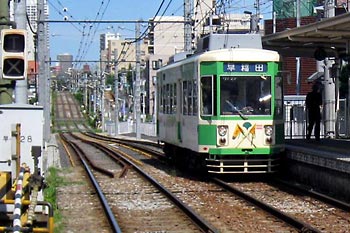
The sole survivor of the street cars in Tokyo - Arakawa-line - runs just a few meters from the entrance.
In the restaurant we can hear Mandarin and Cantonese. A bit dirty and confused space reminds me of Asia, which is a good spice to increase my appetite.
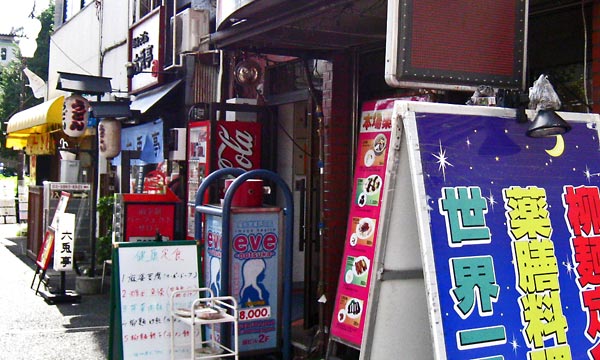
Sekaihanten (right) and its neighbors